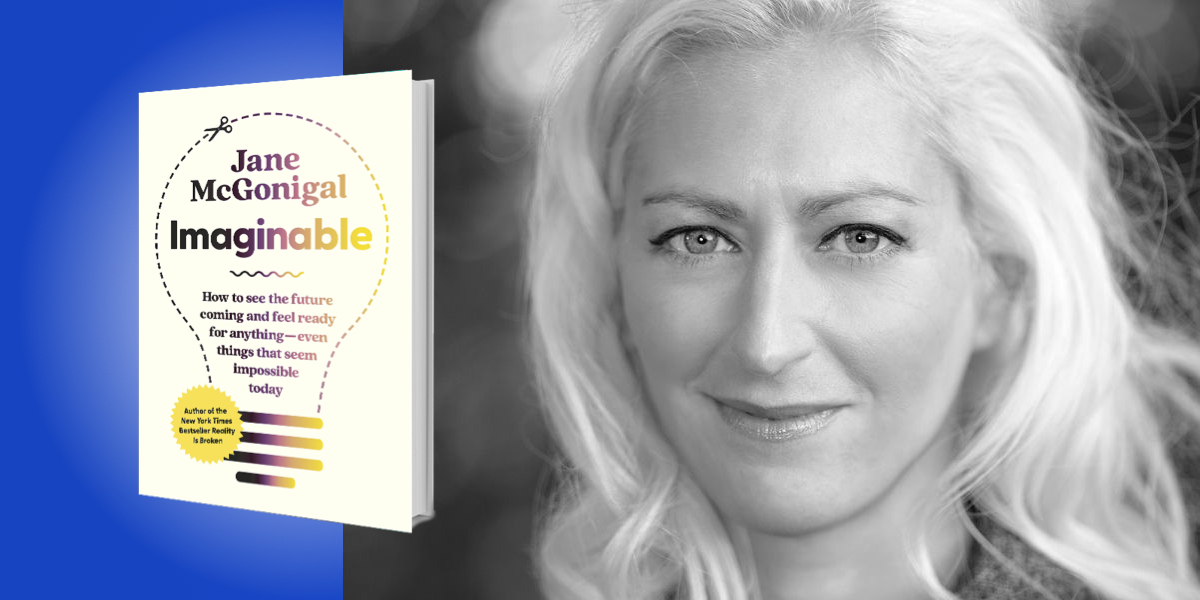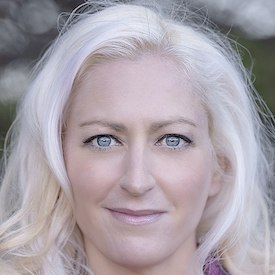Jane McGonigal is the Director of Game Research & Development at the Institute for the Future in Palo Alto, California. She designs games that aim to improve real lives, and solve real problems. For instance, her game SuperBetter has helped more than one million players tackle real-world health challenges, like depression and chronic pain. She has created and deployed games in over 30 countries for partners such as the American Heart Association, the International Olympics Committee, and the World Bank Institute.
Below, Jane shares 5 key insights from her new book, Imaginable: How to See the Future Coming and Feel Ready for Anything―Even Things That Seem Impossible Today. Listen to the audio version—read by Jane herself—in the Next Big Idea App.

1. Take a ten-year trip to the future.
You may be familiar with the saying “The future starts now.” Catchy as it may be, the future doesn’t start now, or tomorrow, or next month—for professional futurists, it starts ten years from today. Ten years because that is enough time for society, and your own life, to become dramatically different. It’s enough time for new technologies to scale up and achieve global impact. It’s enough time for social movements to achieve historic victories. It’s enough time for big new ideas to take root, gain traction, and change the world.
Thinking on a ten-year timeline will lift the ceiling on your imagination and give you that magical feeling of “time spaciousness” to achieve transformative change. It will help you open your mind, take in new information, reduce your blind spots, increase your empathy, set more optimistic goals, and see a much bigger picture. Whenever your mind feels stuck or rushed, give yourself a ten-year deadline, make a ten-year resolution, create an event on your calendar for ten years from today, or talk to others about how the world might be different in ten years. It will change how you think and feel today.
2. Be ridiculous—at first.
At the Institute for the Future, we like to say, “Any useful statement about the future should at first seem ridiculous.” It’s easy to prepare for futures that are similar to today, futures that “make sense” because they seem normal and reasonable. It’s the possibilities that make us say, “That’s ridiculous, that could never happen,” or “I can’t even imagine it”—those are the possibilities we have to spend time taking seriously. Those are the futures that will be most shocking, disruptive, and challenging if they come to pass.
“Any useful statement about the future should at first seem ridiculous.”
Imagine if, in late 2019, you had been asked to consider that, in the near future, virtually all nations will shut and lock down their borders. One billion children will stop going to school and do all of their learning at home. Four hundred million jobs will be deemed nonessential and disappear virtually overnight. It will be against the law to hug your grandmother. (Where I live in California, that was true, thanks to social distancing rules for most of 2020.) In 2019, wouldn’t these ideas have seemed ridiculous at first? But a few months later, they were reality.
We need to prepare our collective imagination for “unimaginable” possibilities—so if they do happen, we’re not frozen with anxiety or stuck in old ways. Any future scenario that you instinctively dismiss reveals a potential blind spot in your imagination. If something feels unimaginable, that’s the tip-off that it is an essential future to start thinking about.
3. Look for clues.
A sculptor works with clay, a computer programmer with code, a chef with ingredients—every form of creativity has its own raw material. For futurists, the raw material is clues. We collect, combine, and build future scenarios out of clues to how the future might be different. To find future clues, you need to develop a way of observing the world in which you spot weird stuff that others overlook. You must constantly home in on things you haven’t previously encountered, things that make you say, “Huh…strange,” and “I wonder why that’s happening.”
“Let these signals spark curiosity . . . Follow the trail of clues wherever it takes you.”
You can see signals all around you. For example, the first time I saw a “No Drone Zone” sign in my local park, I knew it was a signal that drone technology was becoming widespread enough to deserve its own signage. Inspired by this signal of change, I got my own drone and learned more about how drones are being used: journalism, storytelling, activism, art, scientific data collection, urgent delivery services. Finding signals can be as simple as a quick search on news or social media. This week, I searched for “future of learning,” “future of mental health,” and “future of pets.” (That was a particularly fun search—I learned about dinosaur chickens, therapeutic robot cushions, and “how dogs on Mars would live.”) You can also throw in terms like “innovation,” “experiment,” “surprising,” “trend,” “leading-edge,” “weird,” “strange,” “creative idea,” “new phenomenon,” “scientific study.”
Make it a habit to find at least one new signal of change every week, or even every day. Let these signals spark curiosity. What would the world be like if these signals of change became more common? Follow the trail of clues wherever it takes you.
4. Turn the world upside-down.
This is my favorite way to come up with ridiculous (at first) ideas for the future. If your imagination feels stuck in the present, then rewrite the facts of today. Make a list of up to a hundred things that are true today, then flip them upside-down. Rewrite every fact so that the opposite is true. For example, you could say that libraries are mostly quiet spaces. Flip that fact upside-down: ten years from today, libraries are loud, raucous, wild spaces. Envision it is a vividly as you can. What’s happening in libraries to make them feel and sound so different?
“Turning the world upside-down can help clarify what changes you want in society and your own life.”
If thinking about the future of democracy, you could say that today there’s a minimum voting age. Flip that upside down: ten years from now, there’s no minimum voting age, babies can vote. Picture it—children voting! What does that look like? How does it change politics?
Whatever you come up with, spend time mentally immersed in “upside-down worlds.” Make sense of why these changes could happen. How does this new reality work? Look for clues—in the news, on social media, and in your own life—that make these flipped facts seem more plausible. Type your flipped facts into search engines and discover signals of change that you would otherwise have missed. This is a fun, mind-stretching game, but it’s also profound. Turning the world upside-down can help clarify what changes you want in society and your own life.
5. Build urgent optimism.
Urgent optimism is a highly motivating, resilient mindset made up of three key psychological strengths: mental flexibility, realistic hope, and future power.
Mental flexibility is the ability to recognize that anything can become different in the future, even things that seem impossible to change today.
Realistic hope is a balance of positive and shadow imagination. It’s knowing which threats it makes sense to worry about and which new solutions, technologies, and ideas it makes sense to be excited about.
Future power is a feeling of control and agency to directly impact the future, by taking intentional action today.
The good news is that urgent optimism is not a fixed personality trait. It changes throughout our lives and, crucially, it’s changeable—we can purposefully build more of it through future imagination training.
To listen to the audio version read by author Jane McGonigal, download the Next Big Idea App today:
































